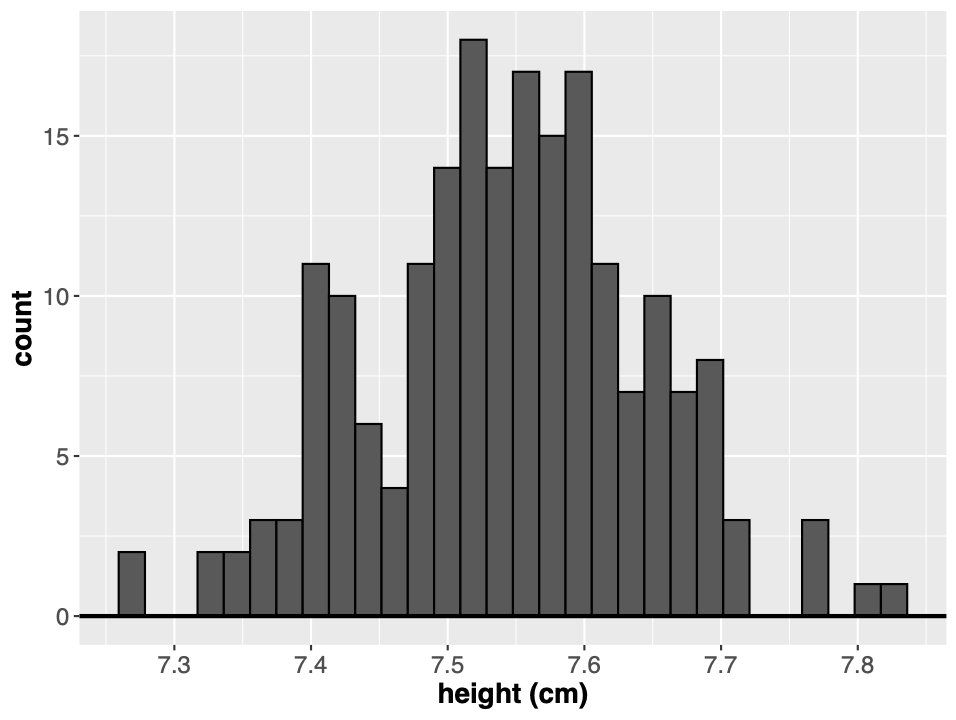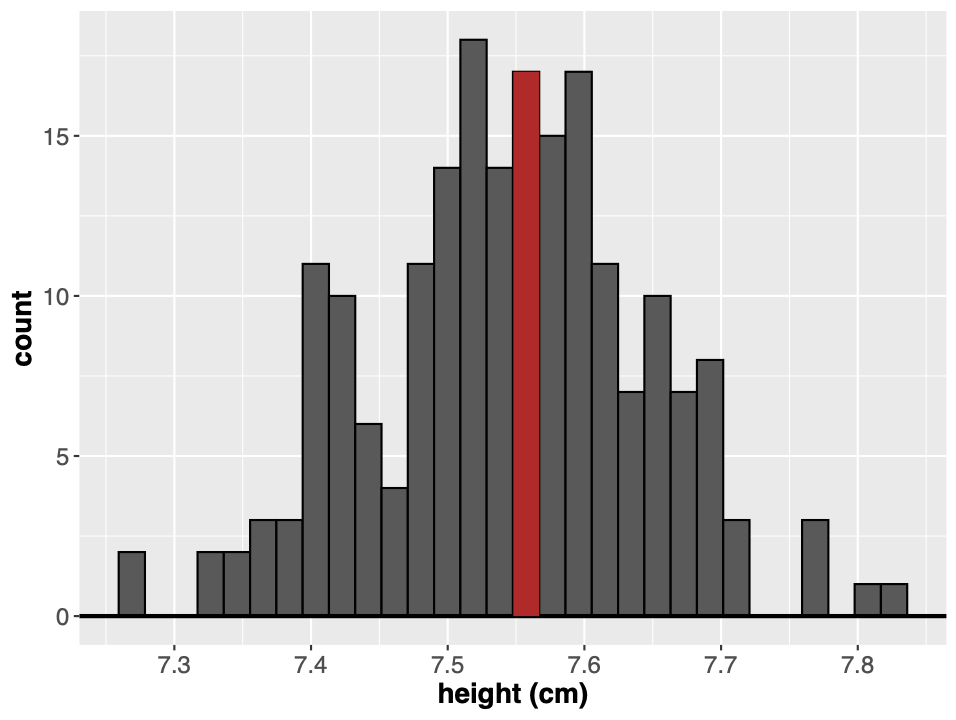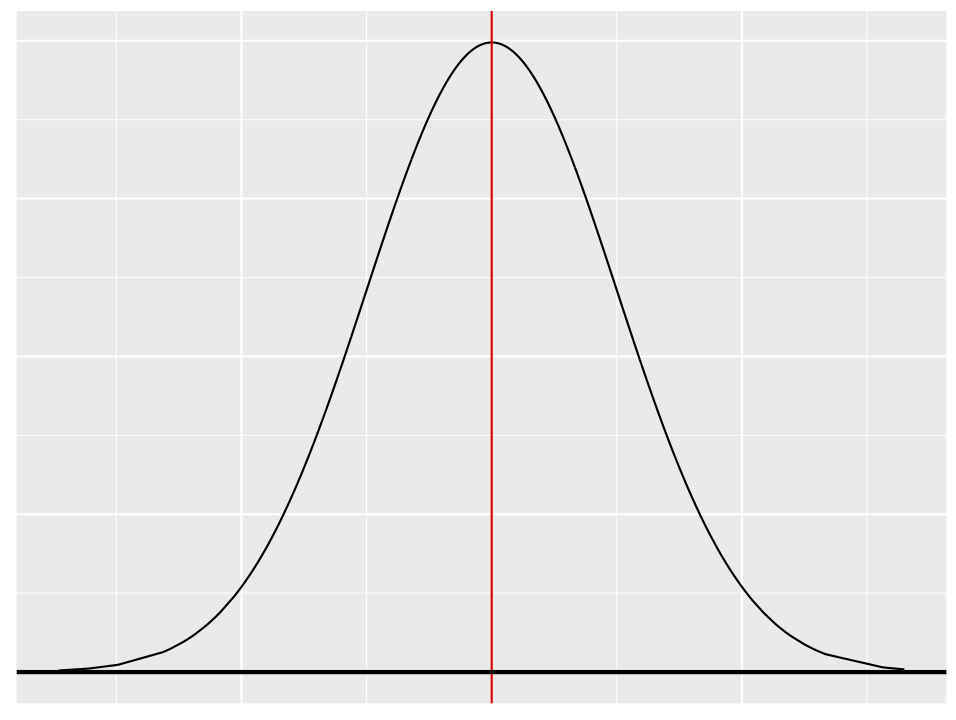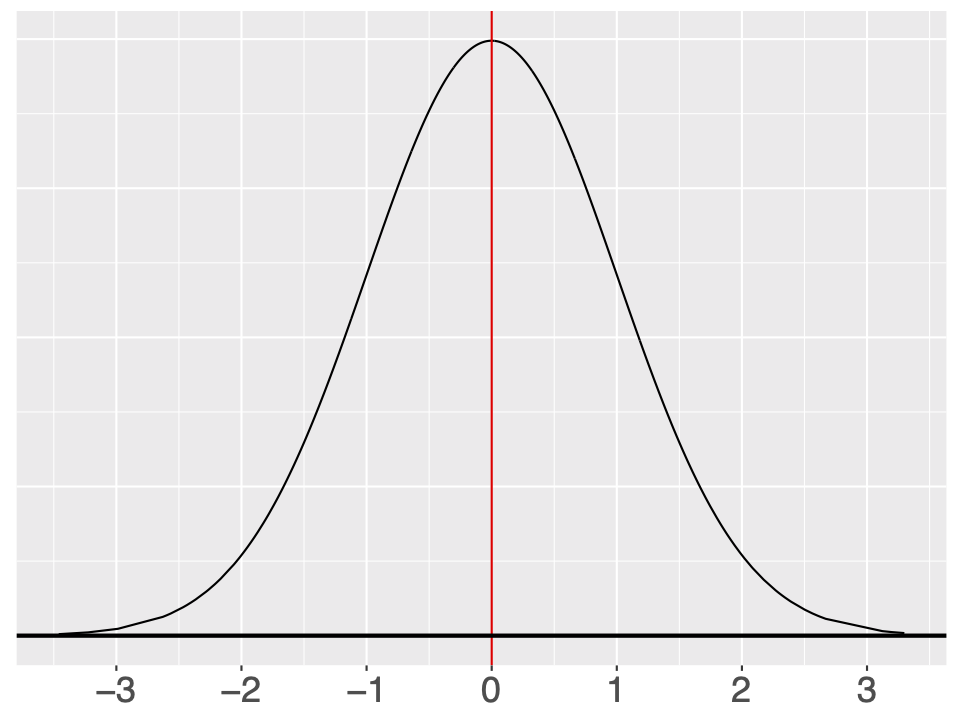class: center, middle, inverse, title-slide .title[ # <b>Week 2: Measurement and Distributions</b> ] .subtitle[ ## Univariate Statistics and Methodology using R ] .author[ ### USMR Team ] .institute[ ### Department of Psychology<br/>The University of Edinburgh ] --- ## Today's Key Topics + Histograms & Density Plots + The Normal Distribution + Populations & Samples + Central Limit Theorem --- class: inverse, center, middle # Part 1 <img src="lecture_2_files/img/Playmo3.jpg" width="40%" style="display: block; margin: auto;" /> --- # Measurement + When we measure something, we attempt to identify its **true measurement**, or the **ground truth** + The problem is that we don’t have any way of measuring accurately enough + Our measurements are likely to be close to the truth + They will likely vary if we take multiple measures + Let’s run a quick experiment: <img src="lecture_2_files/img/Playmo3.jpg" width="25%" style="display: block; margin: auto;" /> --- # Measurement We might expect values close to the **true measurement** to be more frequent if we take multiple measurements: .pull-left[ <img src="lecture_2_files/img/MeasurementPlot.png" style="display: block; margin: auto auto auto 0;" /> ] .pull-right[ <pre> </pre> <img src="lecture_2_files/img/Playmo3.jpg" width="35%" /> (Though there are still limits to our precision) ] --- # Histograms Considering this principle, it might be useful to create a histogram of all measurements taken. .pull-left[ <!-- --> ] -- .pull-right[ **Note difference from a bar chart:** + Histogram represents **continuous** data + Bar Chart represents **categorical** data <img src="lecture_2_files/img/Bar.png" width="70%" /> ] ??? - the height of the bars represent the numbers of times we obtain each value - but why are the bars not touching each other? --- # Histograms Considering this principle, it might be useful to create a histogram of all measurements taken. .pull-left[ <!-- --> ] .pull-right[ + We know that there are 17 measurements around 7.55 + Strictly, between 7.548 & 7.567 ] --- # Histograms in R .pull-left[ ```r df <- data.frame(x=rnorm(200, mean = 7.55, sd = 0.1)) head(df) ``` ``` ## x ## 1 7.609 ## 2 7.614 ## 3 7.471 ## 4 7.578 ## 5 7.491 ## 6 7.524 ``` ] .pull-right[ ```r hist(df$x) ``` <img src="lecture_2_files/figure-html/unnamed-chunk-9-1.svg" width="75%" /> ] --- # Histograms in R .pull-left[ ```r df <- data.frame(x=rnorm(200, mean = 7.55, sd = 0.1)) head(df) ``` ``` ## x ## 1 7.780 ## 2 7.461 ## 3 7.514 ## 4 7.638 ## 5 7.476 ## 6 7.583 ``` ] .pull-right[ ```r library(ggplot2) ggplot(df, aes(x)) + geom_histogram(colour='black') ``` <img src="lecture_2_files/figure-html/unnamed-chunk-11-1.svg" width="60%%" /> <span style="color:red; font-family:monospace">stat_bin() using bins = 30. Pick better value with binwidth.</span> ] --- # Histograms in R Note that the bin width of the histogram matters. Every figure below displays the same data. .pull-left[ <img src="lecture_2_files/img/Histogram1.png" width="55%" /> ggplot default <img src="lecture_2_files/img/Histogram3.png" width="55%" /> binwidth = .05 ] .pull-right[ <img src="lecture_2_files/img/Histogram4.png" width="55%" /> binwidth = .1 <img src="lecture_2_files/img/Histogram5.png" width="55%" /> binwidth = .01 ] --- # Histograms + The Good + Way to examine the *distribution* of the data + Easy to interpret (*y* axis = counts) + Sometimes helpful in spotting weird data (**outliers**) -- <!-- --> --- # Histograms + The Good + Way to examine the *distribution* of the data + Easy to interpret (*y* axis = counts) + Sometimes helpful in spotting weird data (**outliers**) + The Bad + Only gives us information about distribution and mode; doesn't give us other information + E.g., the mean or median + Changing bin width can completely change the graph --- # Density Plots + Similar to histogram in that it shows the distribution of the data + However, the *y* axis is no longer a count, but represents a **proportion** of cases. + The area under the curve is equal to 1 (or 100%, reflecting all cases) .pull-left[ <img src="lecture_2_files/figure-html/unnamed-chunk-18-1.svg" width="70%" height="70%" /> ] -- .pull-right[ <img src="lecture_2_files/figure-html/unnamed-chunk-19-1.svg" width="70%" height="70%" /> ] ??? Created using a kernel function that smooths the data --- # Density Plots in R .pull-left[ **ggplot** ```r ggplot(df, aes(x)) + geom_density() ``` <img src="lecture_2_files/figure-html/unnamed-chunk-21-1.svg" width="70%" height="70%" /> ] .pull-right[ **base R** ```r densDat <- density(df$x) plot(densDat) ``` <img src="lecture_2_files/figure-html/unnamed-chunk-22-1.svg" width="70%" height="70%" /> ] --- class: inverse, center, middle # Part 2 ##The Normal Distribution --- # The Normal Distribution .pull-left[ + A hypothetical density plot + Probability distribution of a random variable + Normal curves are unimodal, with values symmetrically distributed around the peak + Centered around the mean + A higher proportion of cases near the mean and a lower proportion of cases with more extreme values ] .pull-right[ <!-- --> ] --- # The Normal Distribution .pull-left[ Normal curves can be defined in terms of *two parameters*: + The **mean** of the distribution ( `\(\bar{x}\)`, or sometimes `\(\mu\)` ) ```r x <- c(22, 24, 21, 19, 22, 20) mean(x) ``` ``` ## [1] 21.33 ``` + The **standard deviation** of the distribution ( `\(\textrm{sd}\)`, or sometimes `\(\sigma\)` ) ```r sd(x) ``` ``` ## [1] 1.751 ``` ] .pull-right[ <!-- --> ] --- # A quick note on standard deviation The **standard deviation** is the average distance of observations from the mean `$$\textrm{sd}=\sqrt{\frac{\sum{(x-\bar{x})^2}}{n-1}}$$` *x* = individual observation `\(\bar{x}\)` = mean n = sample size `\(\sum\)` = add it up --- # How do these features affect the normal curve? <img src="lecture_2_files/figure-html/unnamed-chunk-27-1.svg" style="display: block; margin: auto;" /> -- The *mean* determines where the curve is centered. --- # How do these features affect the normal curve? <img src="lecture_2_files/figure-html/unnamed-chunk-28-1.svg" style="display: block; margin: auto;" /> The *mean* determines where the curve is centered. --- # How do these features affect the normal curve? <img src="lecture_2_files/figure-html/unnamed-chunk-29-1.svg" style="display: block; margin: auto;" /> The *mean* determines where the curve is centered. -- The *standard deviation* determines the shape of the curve --- # How do these features affect the normal curve? <img src="lecture_2_files/figure-html/unnamed-chunk-30-1.svg" style="display: block; margin: auto;" /> The *mean* determines where the curve is centered. The *standard deviation* determines the shape of the curve --- # How do these features affect the normal curve? <img src="lecture_2_files/figure-html/unnamed-chunk-31-1.svg" style="display: block; margin: auto;" /> The *mean* determines where the curve is centered. The *standard deviation* determines the shape of the curve --- class: inverse, center, middle # Part 3 ## Sampling from a Population --- # Samples vs Populations + **Population** – all members of the group that you are hypothesizing about + **Sample** – the subset of the population that you’re testing to find the answer + If we repeatedly sample from a population and measure the mean of each sample, we'll get a normal distribution + the mean will be (close to) the population mean + the standard deviation ("width") of the distribution of sample means is referred to as the **standard error** of the distribution <img src="lecture_2_files/img/playmo_pop.jpg" width="45%" style="display: block; margin: auto;" /> ??? We want to say something about the population, rather than about one playmobile figure For example -- what's their average height? (We know this, it's on the packet, 7.5cm, but in the real world people differ...) Let's go into RStudio and do a little simulation. --- # Statistical Estimates - so far, we've talked about sampling repeatedly from a population - this might not be possible - if we only have one sample we can make _estimates_ of the mean and standard error + the estimated _mean_ is the sample mean (we have no other info) + the estimated _standard error_ of the mean is defined in terms of the sample standard deviation $$ \textrm{se} = \frac{\sigma}{\sqrt{n}} = \frac{\sqrt{\frac{\sum{(x-\bar{x})^2}}{n-1}}}{\sqrt{n}} $$ --- class: inverse, center, middle # Part 4 ## Towards Statistical Testing --- # Central Limit Theorem - What we have just seen is a demonstration of **Central Limit Theorem** - Lay version: _sample means will be normally distributed about the true mean_ - The more samples you take, the more normal the distribution should look, regardless of the variable's distribution in the population <img src="lecture_2_files/figure-html/unnamed-chunk-33-1.svg" width="28%" /><img src="lecture_2_files/figure-html/unnamed-chunk-33-2.svg" width="28%" /><img src="lecture_2_files/figure-html/unnamed-chunk-33-3.svg" width="28%" /> ??? Why does this even matter? Understanding where a score falls on the normal curve tells us how extreme it is. --- # The Standard Normal Curve .pull-left[ We can *standardize* any value on any normal curve by: + subtracting the mean + the effective mean is now *zero* + dividing by the standard deviation + the effective standard deviation is now *one* These new standardized values are called **z-scores**. The standardized normal distribution is also known as **the z-distribution**. ] .pull-right[ <!-- --> $$ z_i = \frac{x_i - \bar{x}}{\sigma} $$ ] ??? z-distribution - the normal distribution where the mean is 0 and standard deviation is 1 --- # The Standard Normal Curve .pull-left[ + **~68% of observations** fall <B>within one</B> standard deviation of the mean. + ~32% of observations fall <B>greater than one</B> standard deviation above or below the mean ] .pull-right[ <!-- --> ] --- # The Standard Normal Curve .pull-left[ + **~95% of observations** fall <B>within 1.96</B> standard deviations of the mean + ~5% of observations fall <B>greater than 1.96</B> standard deviations above or below the mean + We can phrase it another way: _an area of .95_ lies between -1.96 and 1.96 standard deviations from the mean + "95% of predicted observations" (the 95% confidence interval) ] .pull-right[ <!-- --> ] ??? So scores that fall outside this range are rare --- # Can We Use This For Real? - we have some survey data from the USMR class last year, including _height_ in cm - perhaps we're interested in the "average height of a young statistician" (!) -- + "young statisticians" are a **population** -- + the USMR class of 2021 is a **sample** -- .pt2[ ] .br3.center.pa2.pt2.bg-gray.white.f3[ Can we use the information from the sample of 386 responses we have to say anything about the population? ] --- # Looking at the class data .pull-left[ ```r ggplot(hData, aes(height)) + geom_histogram(colour = 'black', binwidth = 1) + labs(x = 'height (cm)') ``` <!-- --> ] .pull-right[ ```r head(hData$height) ``` ``` ## [1] 171 149 173 159 157 177 ``` ```r mean(hData$height) ``` ``` ## [1] 167.9 ``` ```r sd(hData$height) ``` ``` ## [1] 8.23 ``` ] --- # Statistically Useful Information Remember, in normally distributed data, 95% of the data fall between `\(\bar{x}-1.96\sigma\)` and `\(\bar{x}+1.96\sigma\)` -- .pull-left[ ```r mean(hData$height) + 1.96*sd(hData$height) ``` ``` ## [1] 184 ``` ```r mean(hData$height) - 1.96*sd(hData$height) ``` ``` ## [1] 151.7 ``` ] -- .pull-right[ <!-- --> ] .br3.center.pa2.pt2.bg-gray.white.f3[If we measure the mean height of 386 people from the same population as the USMR class, we estimate that the answer we obtain will lie between **151.7cm** and **184cm** 95% of the time] --- # The Aim of the Game - As statisticians, a major goal is to infer from **samples** to **populations** - More about how we do this next time ??? Understanding whether scores are extreme because of another outside variable (versus due to random variability) is a key priority of statistical analysis. --- # Today's Key Points + The distribution of data can be visualized with histograms and density plots + Normally distributed data are symmetrically distributed, with scores near the mean being measured more often than scores further away + Populations include every member of a group of interest, while a sample includes only those members being observed or tested + The Central Limit Theorem states that as sample size increases, a variable's distribution begins to approximate the normal distribution.